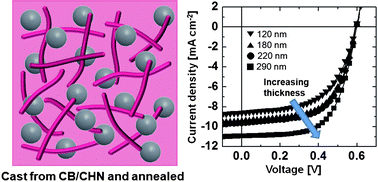Here, we report the preparation of well-controlled nanoscale morphologies in photoactive thin films. The fabrication of bulk heterojunction structures in blend films of poly(3-hexylthiophene) (P3HT) and [6,6]-phenyl-C61-butyric acid methyl ester (PCBM) employed two steps to achieve first the in situ formation of self-organized P3HT nanowires using a marginal solvent, and second, phase separation via mild thermal annealing. Morphological changes in the active layers that had been spin-cast from a marginal solvent, with varying annealing temperatures, were systematically studied and compared to the morphologies of films spin-cast from a good solvent. The interpenetrating nanowire structure yielded power conversion efficiencies as high as 4.07% due to the enhanced charge transport. Hole and electron mobilities increased substantially to 1.6 × 10−3 cm2 V−1 s−1 and 1.4 × 10−3 cm2 V−1 s−1, respectively, due to the two step process of P3HT crystallization by nanowire formation and subsequent phase separation. Photovoltaic performances improved with increasing film thickness up to 300 nm as a result of the interpenetrating donor/acceptor network structure.

You have access to this article
 Please wait while we load your content...
Something went wrong. Try again?
Please wait while we load your content...
Something went wrong. Try again?


 Please wait while we load your content...
Please wait while we load your content...